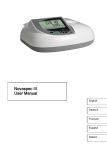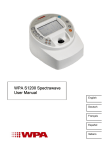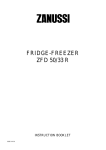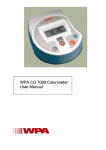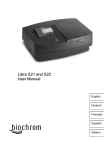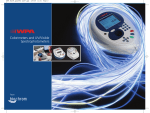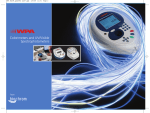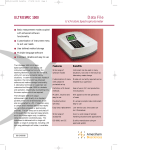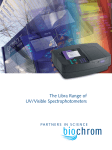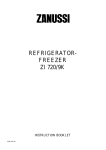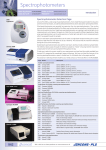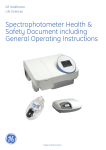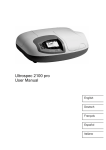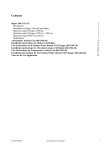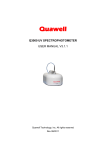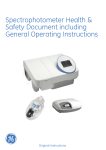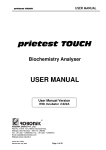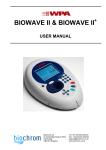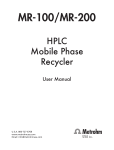Download WPA S800 Spectrawave User Manual
Transcript
WPA S800 Spectrawave User Manual English Deutsch Français Español Italiano Biochrom Ltd Certificate No. 890333 Declaration of Conformity This is to certify that the WPA S800 Visible Spectrophotometer Part number 80-3003-50 Serial number 88000 onwards manufactured by Biochrom Ltd. conform to the requirements of the following Directives-: 73/23/EEC & 89/336/EEC Standards to which conformity is declared EN 61 010-1: 2001 Safety requirements for electrical equipment for measurement, control and laboratory use. EN 61326: 1998 Electrical equipment for measurement, control and laboratory use – EMC requirements Dated: 26th Oct 2004 Signed: David Parr Managing Director Biochrom Ltd Postal address Telephone Telefax Biochrom Ltd 22 Cambridge Science Park Milton Road Cambridge CB4 0FJ England +44 1223 423723 +44 1223 420164 e mail: [email protected] website: http://www.biochrom.co.uk Registered in England No: 3526954 Registered Office: 22 Cambridge Science Park, Milton Road, Cambridge CB4 0FJ, England. CONTENTS Unpacking, Positioning and Installation Essential Safety Notes OPERATION Introduction Sample handling tips Using the Instrument Absorbance and % Transmission Concentration Rate Factor (time and date) Use with serial printer Use with chart recorder USE WITH PC AND THE GRAFICO PC UTILITY SOFTWARE 1 1 2 2 2 3 4 4 6 7 8 8 8 9 Installation Introduction Menu Descriptions Practical Aspects 9 9 10 11 ACCESSORIES 12 ERROR MESSAGES 12 MAINTENANCE 13 After Sales Support Cleaning and general care of the instrument Changing cell holder or removal for cleaning Lamp Replacement Changing the brightness of the display STUDENT EXPERIMENTS Calculation of λ max, extinction coefficient and measurement of natural bandwidth Construction of concentration plots Measurement of stray light SPECIFICATION AND WARRANTY 13 13 13 14 14 15 16 16 17 18 Unpacking, Positioning and Installation • • • • • Inspect the instrument for any signs of damage caused in transit. If any damage is discovered, inform your supplier immediately. Check the position of the metal lamp bracket inside the lamp access area. Ensure your proposed installation site conforms to the environmental conditions for safe operation: Indoor use only Temperature 5°C to 35°C. Note that if you use the instrument in a room subject to extremes of temperature change during the day, it may be necessary to recalibrate (by switching off and then on again) once thermal equilibrium has been established (2-3 hours). Maximum relative humidity of 80 % up to 31°C decreasing linearly to 50 % at 40°C The instrument must be placed on a hard, flat bench or table that can take its weight (<2 kg) such that air is allowed to circulate freely around the instrument. This equipment must be connected to the power supply with the power cord supplied. It can be used on 90 - 240V supplies. Switch on the instrument via the display after it has been plugged in. The instrument performs a series of self-diagnostic checks for lamp performance, wavelength calibration and diode array pixels; press F2 to proceed. If the instrument has just been unpacked or has been stored in a cold environment, it should be allowed to come to thermal equilibrium for 2-3 hours in the laboratory before switching on to prevent calibration failure as a result of internal condensation. • The cell holder supplied with the instrument accepts standard 10mm pathlength glass or plastic cells (adapters are available to convert it to accept 10, 12 and 16mm diameter test tubes). It can be removed for cleaning if spillages occur by undoing the screws that hold it or it can be flushed through with water in situ. If this equipment is used in a manner not specified or in environmental conditions not appropriate for safe operation, the protection provided by the equipment may be impaired and instrument warranty withdrawn. Essential Safety Notes There are a number of warning labels and symbols on your instrument. These are there to inform you where potential danger exists or particular caution is required. Before commencing installation, please take time to familiarise yourself with these symbols and their meaning. Caution (refer to accompanying documents). Background colour yellow, symbol and outline black. ___________________________________________________________________ Issue 02 - 03/2005 WPA S800, English 1 OPERATION Introduction Your spectrophotometer is a simple-to-use instrument that provides rapid measurement of light absorbance and light transmission in the visible region (330 – 800 nm). Your spectrophotometer has facilities for measurement of: • • • absorbance and % transmission concentration, either • absorbance multiplied by a factor or • from a single point calibration using a known standard rate (absorbance against time) at one or two wavelengths simultaneously • rate results at one wavelength can be output to chart recorder The instrument is supplied with Grafico PC utility - on the accompanying CD - and a serial lead. These provide the user with the means to capture, print and store data from the instrument to a PC. Specifically it • • • • produces a printable graphical plot of the scan, in Abs logs date, time and serial number with any output from the instrument produces a results log in order to store, tabulate and subsequently print output from the instrument enables export of the output from the instrument to Excel as a text file A tutorial on UV/Visible spectrophotometry is included as part of the Grafico software. Experiments are included in this manual for the user or for students to investigate some of the principles of UV/Visible spectrophotometry. Sample handling tips • • • Note that the light beam shines from front to back through the cell chamber; ensure the cell is inserted in the correct alignment. The optical height is 15mm, and the minimum volume that can be used is approx. 700µl in a semi-micro cell. Align the indicator line on test tubes with the arrow on the cell compartment area to ensure reproducible positioning of the tube. Note that test tubes do not last forever, and that the surface gets scratches and blemishes through repetitive use; if this is the case they should be replaced. ___________________________________________________________________ Issue 02 - 03/2005 WPA S800, English 2 Using the Instrument The liquid crystal display is very easy to navigate around using the function / select and arrow keys on the hard wearing, spill proof membrane keypad. Keypad √ R T 34 56 To switch the instrument on, press once To switch the instrument off, hold the key down for 2 seconds To set up or confirm an entry To set reference to 0.000AU or 100%T on a reference solution at the selected wavelength To make a measurement or stop a rate experiment To highlight the 6 measurement indicators in turn (see below) Depends on mode, see below rrrr “0.123” flashing Highlight your selection using 34, then: To enter wavelength; to select, press 56 then √ To measure Abs or %T; to select, press 56 (“Abs” or “%T” displayed at side) To measure concentration either using a factor or relative to a known standard; to select, press √ (“Conc.” displayed at side) To measure absorbance as a function of time; to select, press √ To enter a factor for use in concentration; to select, press √ To display time and change time / date if required; to select, press √ The following symbols appear and signify the following: Setting reference / measuring blank Displaying previously measured value when measuring sample Error Messages FAIL flashing FAIL constant Error messages may appear on the display and mean the following: Can carry on using; refer to error messages section Cannot use; refer to error messages section and contact your supplier Display nm Abs/%T Conc Rate Factor ___________________________________________________________________ Issue 02 - 03/2005 WPA S800, English 3 Absorbance and % Transmission This mode is for simple absorbance measurements on samples, measuring the amount of light that has passed through a sample relative to a blank (this can be air). The procedure is as follows: Action Set wavelength Select Abs/%T Insert reference Insert sample Repeat as necessary Press key 3 to get to nm 56 to set √ to select 5 to change between them R to set reference T to measure sample Comment Ramps with increasing speed Moves to Abs/%T Used for subsequent samples until changed Value is displayed Concentration This mode is for measuring the concentration of a sample using a pre-stored factor; note that if you have a standard of known concentration, the instrument will calculate the factor for you. To measure sample using a stored factor, the procedure is as follows: Action Set wavelength Select Conc Press key 3 to get to nm 56 to set √ to select 4 to get to Conc Insert reference R to set reference Insert standard T to measure standard Insert sample T to measure sample Comment Ramps with increasing speed Moves to Abs/%T Each wavelength can have its own factor applied to it Used for subsequent samples until changed Entered standard value flashes Measures absorbance of standard 0.000 is displayed Concentration relative to standard is displayed Repeat as necessary To set a factor manually for use in concentration measurements, go to Factor mode (see later in manual). ___________________________________________________________________ Issue 02 - 03/2005 WPA S800, English 4 To measure the concentration of a sample relative to that of a known standard solution (a one point calibration), the procedure is as follows: Action Set wavelength Enter concentration of known standard digit by digit Press key 3 to get to nm 56 to set √ to select 4 to get to Conc √ to select 56 then 4 at any time √ at any time 56 then 4 56 then 4 56 then 4 34 then 4 √ Insert reference R to set reference Insert standard T to measure standard Insert sample T to measure sample Select Conc Comment Ramps with increasing speed Moves to Abs/%T Entry of first digit (eg 1.234) [Escape during entry] [Enter number, decimal points flash] Entry of second digit (eg 1.234) Entry of third digit (eg 1.234) Entry of fourth digit (eg 1.234) Position of decimal point (eg 123.4) Accept number, entered standard value flashes Used for subsequent samples until changed Entered standard value flashes Measures standard and entered concentration is displayed (factor is calculated). Wavelength appears when measurement finished Concentration relative to standard is displayed Repeat as necessary ___________________________________________________________________ Issue 02 - 03/2005 WPA S800, English 5 Rate This mode is for following a change in absorbance with time at 10 second intervals. If, however, the instrument is connected to a chart recorder the output is linearly fitted between data points as the software automatically interpolates these for the benefit of presentation. The procedure is as follows: Action Set wavelength Select Rate Insert reference Insert sample Press key 3 to get to nm 56 to set √ to select 4 to get to Rate R to set reference T to measure sample Comment Ramps with increasing speed Moves to Abs/%T Used for subsequent samples until changed Absorbance measured every 10 seconds Keeps measuring until the T key is pressed or until 1000 measurements are made Repeat as necessary Note that there is no t = 0 reading; the first reading is that after 10 seconds. You can also measure at two wavelengths simultaneously; this is useful as you can, for example, follow the drop in reactant absorbance and the rise in product absorbance as the reaction proceeds (the first wavelength only is used if a chart recorder is connected). The procedure is as follows: Action Set wavelength Select Rate Set second wavelength Insert reference Insert standard Press key 3 to get to nm 56 to set √ to select 4 to get to Rate 5 to get L2 √ to select 56 to set √ to select R to set reference T to measure sample Comment Set first wavelength Moves to Abs/%T Set second wavelength Pressing √ again reverts back to single wavelength mode Used for subsequent samples until changed Absorbance measured every 10 seconds Display alternates between the two absorbance and wavelength values Keeps measuring until the T key is pressed or until 1000 measurements are made Repeat as necessary Note that there is no t = 0 reading; the first readings are those after 10 seconds. ___________________________________________________________________ Issue 02 - 03/2005 WPA S800, English 6 Factor This mode is for setting a factor to be used in concentration experiments; once this has been done, the instrument moves directly to concentration mode so that it can be used. The procedure is as follows: Action Set wavelength Select Factor Enter factor digit by digit Press key 3 to get to nm 56 to set √ to select 4 to get to Factor √ to select 56 then √ Insert reference 56 then 4 at any time √ at any time 56 then 4 56 then 4 56 then 4 34 √ R to set reference Insert sample T to measure sample Comment Ramps with increasing speed Moves to Abs/%T Enter if factor is positive [POS] or negative [nEG] Entry of first digit (eg 1.234) [Escape during entry] [Enter number, decimal points flash] Entry of second digit (eg 1.234) Entry of third digit (eg 1.234) Entry of fourth digit (eg 1.234) Position of decimal point (eg 123.4) Moves to Concentration mode Used for subsequent samples until changed Concentration calculated from factor and absorbance is displayed Repeat as necessary ___________________________________________________________________ Issue 02 - 03/2005 WPA S800, English 7 (time and date) The time is displayed (24 hour format). To change this and the date so that they are correct, the procedure is as follows: Action Set date Press key √ to select 56 to set day then √ 56 to set month then √ 56 to set year then √ Set time 56 to set hour then √ 56 to set minute then √ Comment Format shown on the display is mm . yy dd dd flashes mm flashes yy flashes Format shown on the display is hh . mm hh flashes mm flashes Time and date are set Time and date values are printed and exported (to Grafico) as a time/date stamp. Note that the date format cannot be set to other than dd/mm/yy; these characters are shown on all instrument output to avoid confusion in countries where other date formats are the norm. Use with serial printer Note that all results can be output to PC using the serial lead and Grafico software supplied on the user manuals CD. Seiko DPU-414 settings: Dip SW-1 Serial, Auto line feed off Dip SW-2 40 column width, International character set, USA Dip SW-3 Baud rate 9600 bps Note that the 80-2108-18 lead that is required will need two small nuts removing before connection. Use with chart recorder Kinetics results can be output to a chart recorder using the appropriate cable (803003-55). Voltage setting is 1V per 1 Absorbance unit (± 10 %) with an offset of 1V = 0.000 Abs on the chart recorder; corresponding %T values are 1V per 100%T (± 10 %) with 0V = 0%T. To make the chart cable yourself, you require a female 9 way D type at one end with two (1 red, 1 black) 4mm banana plugs at the other (depending on the chart recorder) and 2 metres of coaxial cable or screened twin core, with the shield connecting the black plug and pin 5 and the core connecting the red plug and pin 1. ___________________________________________________________________ Issue 02 - 03/2005 WPA S800, English 8 USE WITH PC AND THE GRAFICO PC UTILITY SOFTWARE Your instrument is supplied with a serial lead and Grafico software (on the user manuals CD) that enables it to be connected to a PC so that results can be captured, stored, printed and transferred into other applications easily. In particular, a complete wavelength scan can be visualised on the PC and copied/pasted into a word document or powerpoint presentation. An informative tutorial on aspects of UV/Visible Spectrophotometry is available as part of the software. Installation The software takes up approximately 0.5Mb of hard disk space when installed. Proceed as follows to install the software: 1. Place CD into the CD drive of the PC 2. Use Windows explorer to locate the setup.exe file Grafico folder within the appropriately named instrument folder on the user manuals CD 3. Double click on this so that the software installs, filling out the information as requested. 4. The software can be started directly by Start > Programs > Grafico. Introduction • • • • When Grafico is selected, you are prompted to enter the file details (note that the title entered here is used as the title of the wavelength scan graph). After pressing OK, the instrument (it should be already switched on and connected to the PC with the serial lead) is recognised by the software. There are two parts to the Grafico software, data-logging and scan. The default mode is data-logging; this receives instrument output from absorbance, %T, concentration and rate measurements (including time and date stamp). o Results can be copied from Grafico and pasted directly into Excel for ease of data transfer. Alternatively results can be saved and opened up using Excel. If scan mode is selected (View > Scan mode), the full 330-800nm wavelength scan output from the instrument is shown (just press the run key as usual). Multiple peaks can be identified using a trace routine and labelled if required (by dragging the icon at the left side of the displayed graph and releasing at the appropriate point). o Graphs can be copied and pasted into Word, Excel or powerpoint o Graphs can be saved in a format that can be opened directly by Excel ___________________________________________________________________ Issue 02 - 03/2005 WPA S800, English 9 Menu Descriptions File New Save / Save As Setup Print Print Setup Exit Edit Copy Clear Select All View Scan mode Clears any existing data and starts a new report. Prompts for file details (user name, organisation, title, descriptive text) Saves the data file in the file format selected. The file details are included with this data Displays a tabbed dialogue box so that automatic post process options for saving of graph, printing of graph and the graph scaling parameters can be defined. The default data directory can be defined and is used for all save operations. Prints the entire file, including a header if defined in File>New Runs the Common Print Dialog function to set up the printer Closes the application Copies the data to clipboard for pasting into another application; in data-logging and scan modes this is text and graphic, respectively Clears the data from the data set Selects data and header together Set scale Display grid Toolbar Status bar Switches between scan and data logging modes. Successive scans overwrite existing scans on the display and can be saved if the autosave function is on Shows the file details entered at the start (or after File > New) and allows modification of these details, if required Automatically sets the scale of the absorbance axis to optimise presentation (2.5, 2.0, 1.5, 1.0, 0.5, 0.2 or 0.1A) Sets the scale to user preference (Full, Auto, Define) Toggles on/off the grid on the graph (for presentation purposes) View menu bar as icons View status bar at bottom of display Help Tutorial Help topics About View tutorial on UV/Visible spectrophotometry View help topics View version number etc File details Autoscale ___________________________________________________________________ Issue 02 - 03/2005 WPA S800, English 10 Practical Aspects Data logging mode • When exporting rate mode results you can add the time in 10 second intervals to the spreadsheet manually (note that first data point is after 10 seconds, not zero seconds) and then graph the absorbance / time data (see scan mode – export to excel for more details). Scan mode • Files can be saved as *.txt, *.csv (opens directly in Excel when double clicked) or *.wmf (picture) formats • Label a peak by dragging and releasing the icon at the left side of the graph. The absorbance/wavelength details are shown in the title bar. Dragging it again moves the label; moving it the left hand side takes the label away. Multiple peaks can be added. • Use display grid off for clearer presentation. • Data can be output in absorbance only Scan mode – export to Excel and graphing • If saving as a *.txt file, save the results to folder of choice. o Use Excel to open this file; with files of type set to “all files” o Note that saving as a *.csv file and double clicking on it will open Excel directly • Highlight the wavelength and absorbance values and click the graph icon • Select chart type “XY Scatter” and the curved lines (no data points) option • Label the axes etc as required • Double click on the x-axis, select Scale and minimum to 330 and maximum to 800 • Set colour scheme to suit your preferences ___________________________________________________________________ Issue 02 - 03/2005 WPA S800, English 11 ACCESSORIES PC serial cable (spare) S1000P serial printer (includes serial printer cable) Seiko DPU-414 printer Serial cable for Seiko printer Chart recorder interface cable Test tube adapters (10, 12, 16mm) 80-3001-00 80-3002-53 80-2108-80 80-2118-18 80-3003-55 80-2117-47 ERROR MESSAGES After switch on, the instrument undergoes self-diagnostic tests for the tungsten lamp, wavelength calibration and diode array as part of its calibration procedure. In the unlikely event of an internal instrument error, the word FAIL will appear on the display together with a symbol and a number; if FAIL is flashing the instrument can still be used, but if FAIL is constant the instrument cannot be used. The error messages that are displayed as follows: Error code Symbol FAIL Comment and action 009 ! Flashing Lamp ageing (too much UV), noisy results change lamp when possible Lamp ageing (too little UV), noisy results change lamp when possible Lamp ageing (too much IR), noisy results change lamp when possible Lamp ageing (to little IR), noisy results - change lamp when possible Wavelength calibration error; can compensate by addition or subtraction of the number displayed, as appropriate, to the wavelength that is required, but contact your local distributor. Press 5 to proceed LED failure, contact your local distributor Lamp failure, change the lamp LED lamp failure, contact your local distributor Pixel clock too high, contact your local distributor Pixel clock too low, contact your local distributor Pixel clock unstable, contact your local distributor PDA failure, contact your local distributor Flashing 003 010 ! Flashing Flashing 004 N (the number of nm that it is out) nm Flashing 011 001 005 006 ! Constant Constant Constant Constant 002 ! Constant 007 ! Constant 008 ! Constant ___________________________________________________________________ Issue 02 - 03/2005 WPA S800, English 12 MAINTENANCE After Sales Support Support agreements that help you to fulfil the demands of regulatory guidelines concerning GLP/GMP are available. • Calibration, certification using filters traceable to international standards • Certificated engineers and calibrated test equipment • Approved to ISO 9001 standard Choice of agreement apart from break down coverage can include • Preventative maintenance • Certification When using calibration standard filters, insert such that the flat surface is facing away from the spring end of the cell holder Observe all necessary precautions if dealing with hazardous samples or solvents. Cleaning and general care of the instrument External cleaning Switch off the instrument and disconnect the power cord. Use a soft damp cloth. Clean all external surfaces. A mild liquid detergent may be used to remove stubborn marks. Changing cell holder or removal for cleaning • Undo the screws that are visible on the top of the cell holder using a small flat headed screwdriver and lift the holder out by holding onto the projection; this may require pushing to the right as you do so in order to prevent fouling against the left side of the instrument cover. If necessary, the cell holder can be helped out by pushing from the bottom of the instrument. • Insert the test tube holder and secure in place using the same screws. • Note that as well removal for cleaning, spillages in the cell holder can be flushed through using water from a squeeze bottle in order to prevent crystallisation / fermentation of residues. ___________________________________________________________________ Issue 02 - 03/2005 WPA S800, English 13 Lamp Replacement A replacement lamp is available from your supplier using the following part numbers: Tungsten Lamp, S1000L 80-2115-33 (use only this tungsten lamp as it is supplied with the connection wires; others will not operate correctly in this spectrophotometer) • • • • The design of the lamp area is such that users are able to change their own lamps. No lamp alignment is necessary as the lamp is pre-aligned. The lamp becomes hot in use. Ensure it is cool before changing it. Do not touch the optical surfaces of the lamp with your fingers (use tissue); if touched, the area should be cleaned with iso-propanol. Instructions for lamp change are provided with the lamp and overleaf. To change the lamp, proceed as follows: 1. 2. 3. 4. 5. 6. Switch off the instrument, remove the sample from the cell holder and disconnect the power supply cord Remove the protective layers at the lamp access and plug in points on the underneath of the instrument Remove the lamp wires from the groove by gently unclipping it Remove the lamp by twisting the lamp assembly anti-clockwise Remove the lamp connection end by gently pulling with your fingers Replace with new lamp using the reverse of these actions Changing the brightness of the display To change display brightness, proceed as follows: 1. 2. 3. Ensure the instrument is on and that there is no sample in the cell holder Remove the protective layer at the lamp plug in point (underneath and at the rear of instrument) Place the instrument on its back, insert a small flat headed screwdriver into the potentiometer slot and turn it right or left until a suitable level of brightness is obtained. ___________________________________________________________________ Issue 02 - 03/2005 WPA S800, English 14 STUDENT EXPERIMENTS The simple experiments that follow are designed to illustrate some of the principles of UV/Visible spectrophotometry, and can be carried out using commonly available chemicals and this instrument (although any instrument could be used). Potassium Dichromate stock solution Potassium dichromate is used in the majority of the experiments. Make a stock solution as follows: 1. Weigh out approx. 0.93g of potassium dichromate (K2Cr2O7) and record the weight accurately. 2. Put the weighed dichromate into a 1 litre volumetric flask and add 100 ml of 0.1 N sulphuric acid. Make up to 1 litre with distilled water, shaking the flask all the time. 3. Calculate the precise concentration by dividing the exact weight of dichromate used (recorded in 1 above) by 294.2 (the relative molecular mass of potassium dichromate). Use the precise weight recorded - in this example assumed to be 0.93g. 0.93 = 0.0031611 294.2 The concentration of the stock solution would in this case be 3.16 x 10-3 mol 1itre-1. 4. Make a series of dilutions of the stock solution as follows: 1 part of stock solution to 9 parts of distilled water, 3 parts of stock solution to 7 parts of distilled water, 5 parts of stock solution to 5 parts of distilled water, 7 parts of stock solution to 3 parts of distilled water, 9 parts of stock solution to 1 part of distilled water. Calculate the concentrations of all dilutions and record them. Apparatus required For weighing A balance accurate to at least ± 0.001 g, spatulas, weighing boats, etc. For measuring volumes ('B' grade equipment is adequate) 1 litre volumetric flask either (a) a range of volumetric flasks and pipettes or (b) two 25 ml burettes or 10 ml graduated pipettes together with glass sample containers (preferably sealed). Other equipment Beakers or conical flasks for distilled water, wash bottle and supply of distilled water, pipette filler bulb, graph paper. Chemicals required (general purpose reagent grade) Potassium dichromate K2Cr2O7 ___________________________________________________________________ Issue 02 - 03/2005 WPA S800, English 15 Sodium nitrite NaNO2, Dilute sulphuric acid (0.1 N) H2SO4 As with all chemicals, care must be taken when handling the above. Any other chemicals that have a visible colour in aqueous solution, e.g. copper sulphate, cobalt chloride, indicator dyes or food colourings. Calculation of λ max, extinction coefficient and measurement of natural bandwidth 1. Put approximately 3 ml of the 1 : 9 dilution in a10 mm cuvette. The concentration will be approximately 3.16 x 10-4 mol-1 2. Set the spectrophotometer wavelength to 330 nm and with nothing in the spectrophotometer light path (or with a cuvette containing distilled water) set reference. 3. Place the cuvette containing the prepared dilution in the sample compartment. Record the absorbance. 4. Repeat steps 2 and 3 at wavelength increments of 10 nm up to 405 nm and record absorbance at each wavelength setting. 5. Plot the results as absorbance against wavelength. 6. To determine more precisely the wavelength of maximum absorbance (λ max) repeat the measurements from 340 to 360 nm at increments of 5 nm. 7. From the graph note the wavelength of maximum absorbance for this solution. NOTE: The PC utility could be used to export a complete wavelength scan if preferred so that steps 4-6 are not required 8. Calculate the molar absorptivity (extinction coefficient) of potassium dichromate, at the wavelength of maximum absorption, using the equation E = A cb The result should be approximately 3150 1 mol-l cm-1 at λ max 350 nm. 9. Project the slopes of the peak at λ max to the base line to give a triangular figure. Estimate the natural bandwidth of this peak by measuring the width of the triangle (in nm from the wavelength axis) at half its height. Construction of concentration plots 1. 2. Set the wavelength of the spectrophotometer to λ max as determined in Experiment 1, and record both absorption and transmission of all the dilutions of the stock solution of potassium dichromate prepared earlier. On the same graph paper prepare two plots, one of absorbance at λ max against concentration and one of transmission against concentration. Note that the absorbance plot is linear to about 1.5A and that the transmission plot is exponential. The flattening of the absorbance plot at higher values is ___________________________________________________________________ Issue 02 - 03/2005 WPA S800, English 16 due to stray light. It is good laboratory practise to measure between 0.1 and 1.0 Abs on any spectrophotometer. Concentration plots similar to that just constructed are used to find the concentration of an unknown sample of the same solution (it is customary to plot only the absorbance values against concentration, not transmission.), the so-called standard curve. If the measured absorbance of the unknown lies outside the linear section of the plot, the reading may be brought within the linear section either by using a cuvette of shorter pathlength or by diluting the sample by a known factor. If a shorter pathlength is chosen the observed absorbance must be multiplied by a factor related to the ratio of the two pathlengths, e.g. if the curve is based on 10 mm cells and a 5 mm cell is used, multiply by 2. If the dilution method is selected, calculate the concentration by multiplying the absorbance by the same factor as the dilution and then read the value from the plot prepared as described above. Measurement of stray light 1. 2. 3. Make up a solution of sodium nitrite (NaNO2) in distilled water at a concentration of 50 g l-l (e.g. 5g in 100 ml) and fill a l0 mm cuvette. Set the wavelength of the spectrophotometer to 340 nm and set the reference (100%T) with nothing in the sample compartment (or with a cuvette filled with distilled water). Put the cuvette containing the sodium nitrite solution in the sample compartment of the spectrophotometer. Sodium nitrite acts as a blocking filter, absorbing all incident radiation at the wavelength selected, but transmitting virtually all of the radiation at longer wavelengths. Therefore any transmission recorded at 340 nm will be a direct measurement of the stray light of the instrument. The value should be in accordance with the manufacturer’s specification. ___________________________________________________________________ Issue 02 - 03/2005 WPA S800, English 17 SPECIFICATION AND WARRANTY Wavelength range Monochromator Wavelength calibration Spectral bandwidth Wavelength accuracy Wavelength reproducibility Light sources Detector Photometric range Photometric linearity Photometric reproducibility Stray Light Stability Noise Analogue output Digital output Dimensions Weight Power input Safety standard EMC emissions EMC immunity Mains harmonics Susceptibility standard Quality System 330 - 800 nm Flat grating Automatic upon switch on 7 nm ± 2nm ± 1nm Pulsed Tungsten halogen Diode array - 0.300 to 2.500A, 0 to 200%T ± 2.0 % or ± 0.010A to 1.000A at 546nm, whichever is the greater < 0.002 A at 0A and 500nm < 1%T 340nm according to ANSI/ASTM E387-72 ± 0.005A/h at 0A and 546nm after warm-up ± 0.002A near 0A and ± 0.020A near 2A at 600nm 1V per 1 Abs (±10%), 1V = 0A offset 1V per 100%T (±10%), 0V = 0%T offset 9 pin serial 180 x 270 x 390 mm 1.75 kg 90-265 V, 50/60 Hz, 15 VA EN61010-1 EN 61326-2.3 Generic emissions EN 61000-4-6 Generic immunity part 1 EN 61000-3-2 IEC 801 Designed and manufactured in accordance with an ISO 9001 approved quality system Specifications are measured after the instrument has warmed up at a constant ambient temperature and are typical of a production unit. As part of our policy of continuous development, we reserve the right to alter specifications without notice. Warranty Your supplier guarantees that the product supplied has been thoroughly tested to ensure that it meets its published specification. The warranty included in the conditions of supply is valid for 12 months only if the product has been used according to the instructions supplied. They can accept no liability for loss or damage, however caused, arising from the faulty or incorrect use of this product. This product has been designed and manufactured by Biochrom Ltd, 22 Cambridge Science Park, Milton Road, Cambridge CB4 0FJ, UK. ___________________________________________________________________ Issue 02 - 03/2005 WPA S800, English 18






















